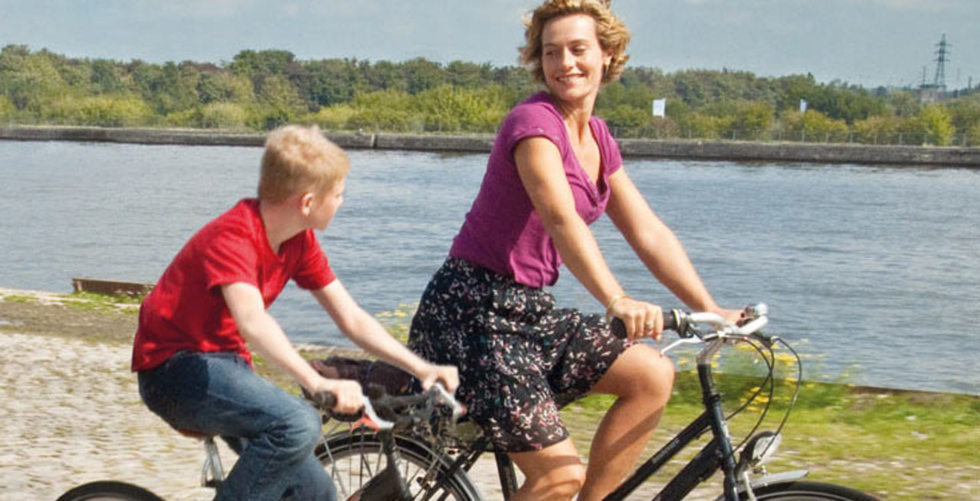
BY ZACHARY WIGON |
Constructed Naturalism from Cannes
The Dardenne Brothers' patented stylistic formula gives The Kid With a Bike an emotional and psychological intelligence rarely found in contemporary cinema.

If there’s a superstar of the international cinephilic community, it would be the Dardenne brothers. Jean-Pierre and Luc Dardenne, who began their careers making documentaries in the 70s and 80s, have had six films at the Cannes Film Festival, and each has won an award there; they’ve won the coveted Palme d’Or twice. It’s not hard to understand why this Belgian duo’s approach has won over so many cineastes: with a rigorous approach to naturalism and an all-encompassing empathy for any character that crosses into their frame, their films have an emotional and psychological intelligence that is rarely glimpsed in contemporary cinema.
Their latest, The Kid With A Bike, is an unvarying entry in their canon. Following Cyril (Thomas Doret), a young kid who is tired of living in a children’s home and wants to be reunited with his father, and Samantha (Cecile de France), a hairdresser who effectively becomes Cyril’s foster mother, the film paints a stark, honest portrait of what it’s like to be young, confused, and without a healthy level of emotional care. I recently sat down with the brothers at their hotel in Manhattan.
Tribeca: Naturalism is a term that is thrown around a lot when discussing your work. Can you tell me a bit about what creates a naturalist aesthetic in cinema, if you accept the term?
Luc Dardenne: I don’t know if one can say naturalistic. We’re interested in the accessories, the props, the details, the way the bodies move. Maybe we’re interested in moments that, in general, cinema considers less important than we do. Movements or moments of action that we register, we record: people doing things. Perhaps also our camera, which is not exactly in the right place. We build the set or the staging almost as if it escapes us, as if we quite can’t control it, as if there’s just enough room for the camera, so it doesn’t allow it to really see properly. It creates the effect of a reality that is hard to see, that is resisting you. We create ellipses in places that are very big, and that’s what people say to us: You create ellipses in places that are peculiar. We throw the viewer into the scene so that he’s right in the action; it’s almost as if the spectator has the feeling that he missed part of the action, and he’s catching up. We try to have that recur in the film, where the viewer says to himself, “Hmm, I missed something.” Eventually he understands, but later.

Tribeca: You constantly choose long takes, and film with a handheld camera. I know you began your careers in documentaries; did those aesthetic decisions come from that background?
Jean-Pierre Dardenne: No, it didn’t come from the documentary work. But it is true that what it does is, [it makes] the time frame the same as the one that it takes to see it – the viewer has the feeling of watching pieces of our film in real time, as reality. But sometimes we say, you know, we have to stop shooting scenes in sequence. When we start working on a new movie, and we start the rehearsal process, it’s bigger than we are. When you work in sequence, there’s a tension that starts to build on the set. Everybody knows that, it can be for let’s say three minutes, and if in the second minute something haphazard happens – it can be good, but it can also be a catastrophe. That creates tension. It’s as if you’re starting to run and then someone’s chasing you, and you have to reach the line. That creates a tension on the set that we like.
Luc Dardenne: And the editing is banned in those kinds of takes.
Jean-Pierre Dardenne: The only editing decision is where we start the scene, and where we close it.
Luc Dardenne: The spectator is caught up in a rhythm – the rhythm of the take. He’s where the camera is, and he really can’t go any other place. That’s what creates intensity and tension – he can’t see what else is happening, he can only see things from one angle. It makes one feel that one can’t dominate or master or control the situation. That came from the Lumiere brothers – 50 seconds, non-stop, no editing.

Tribeca: What are your feelings on the nature of cutting up a scene highly, then – do you find it to be artificial, to edit a scene with different angles?
Luc Dardenne: No, I also like films that are very edited. It’s not the same intensity, it’s a different relationship to the film, but I like it as well.
Tribeca: The film turns on the idea of forgiveness. I’m wondering if you feel like it’s easier for an adult to forgive than a child, and if so, why?
Luc Dardenne: I’m not sure. The adult can forgive under normal circumstances, because he’s able to distance himself. But of course it depends on what you’re forgiving. But the child is so self-involved that he is not yet capable of taking that distance vis-à-vis himself, so it’s more difficult for him to forgive. The bookstore owner’s son was hit and he wants revenge, which is a primal reaction. What we wanted was that when the bookstore owner’s son attacks Cyril, Cyril refuses to fight back. Cyril is not what he was. At the same time, you understand why the bookstore owner’s son wants to fight.

Tribeca: What’s interesting about the sequence is the idea that adults can forgive, but children cannot.
Luc Dardenne: You know, adults want revenge too, though. Think about Yugoslavia. An adult has the capacity to rise above his suffering, despite the fact that it’s hard to have been hit, to have been humiliated. He can rise above it. It’s much more difficult for a child. That’s why there’s capital punishment, though – there is a desire to punish the person who commits a crime. People say, “I want him to die for what he did” – that’s revenge. It’s normal: if you think of a murderer who killed a child, you want him to die. At the same time, you say okay, calm down – I’m not talking about forgiveness, I’m talking about acceptance – you need to do away with that need for revenge, because if you don’t, it’s an unending cycle, it’ll be the end of the world, everyone will kill everyone.
Tribeca: The sequences of watching Cyril ride his bike have a very lyrical feel to them. Can you tell me about how the idea to have his bike be such a central element to the character formed?
Jean-Pierre Dardenne: It was clear that the character would be a character with a bike – he was a solitary person, and his bike was, in a sense, his only friend. The bike is the tool that makes the film move forward – it’s the bike that takes him to see his father, it’s the bike that takes him to the woods, towards evil, it’s the bike that makes the film move. Cyril is his bike. Also, when he’s pedaling on his bike after his father has thrown him out, and it’s for such a long time, that’s where the viewer senses that there is something happening in him internally, that’s changing. And that’s extraordinary. That’s what’s fabulous about film: a bike can be as important as an actor. The importance that props and accessories take on is enormous.
The Kid with a Bike opens in New York and Los Angeles on Friday, March 16. Find tickets.
![]() Like The Kid with a Bike on Facebook.
Like The Kid with a Bike on Facebook.![]() Check in to The Kid with a Bike on GetGlue.
Check in to The Kid with a Bike on GetGlue.
Watch the trailer: